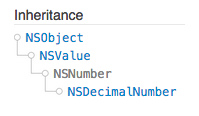The difference among int, NSInteger, NSUInteger and NSNumber
Apple iOS official document is a pretty superior tool.
About NSNumber:https://developer.apple.com/library/ios/documentation/Cocoa/Reference/Foundation/Classes/NSNumber_Class/index.html
<1> NSNumber(It's a Class)
NSNumber is a subclass of NSValue that offers a value as any C scalar (numeric) type.
It defines a set of methods specifically for setting and accessing the value as a signed or unsigned char, short int, int, long int, long long int, float, or double or as a BOOL. (Note that number objects do not necessarily preserve the type they are created with.)
It also defines a compare: method to determine the ordering of two NSNumberobjects.
1. Inheritance Chain

2. Creating an NSNumber Object
+ numberWithBool:
+ numberWithChar:
+ numberWithDouble:
+ numberWithFloat:
+ numberWithInt:
+ numberWithInteger:
+ numberWithLong:
+ numberWithLongLong:
+ numberWithShort:
+ numberWithUnsignedChar:
+ numberWithUnsignedInt:
+ numberWithUnsignedInteger:
+ numberWithUnsignedLong:
+ numberWithUnsignedLongLong:
+ numberWithUnsignedShort:3. Initializing an NSNumber Object
- initWithBool:
Designated Initializer
- initWithChar:
Designated Initializer
- initWithDouble:
Designated Initializer
- initWithFloat:
Designated Initializer
- initWithInt:
Designated Initializer
- initWithInteger:
Designated Initializer
- initWithLong:
Designated Initializer
- initWithLongLong:
Designated Initializer
- initWithShort:
Designated Initializer
- initWithUnsignedChar:
Designated Initializer
- initWithUnsignedInt:
Designated Initializer
- initWithUnsignedInteger:
Designated Initializer
- initWithUnsignedLong:
Designated Initializer
- initWithUnsignedLongLong:
Designated Initializer
- initWithUnsignedShort:
Designated Initializer4. Accessing Numeric Values
boolValue
Property
charValue
Property
decimalValue
Property
doubleValue
Property
floatValue
Property
intValue
Property
integerValue
Property
longLongValue
Property
longValue
Property
shortValue
Property
unsignedCharValue
Property
unsignedIntegerValue
Property
unsignedIntValue
Property
unsignedLongLongValue
Property
unsignedLongValue
Property
unsignedShortValue
Property
<2> NSInteger (It's NOT a class)
You usually want to use NSInteger when you don't know what kind of processor architecture your code might run on.
So you may for some reason want the largest possible int type, which on 32 bit systems is just an int, while on a 64-bit system it's a long.
That's why NSInteger born.
Attention:some of elder iOS devices are 32-bit systems while new devices are 64-bit system.
This means you are supposed to use
"%d" or "%ld" in different situations.
<3> NSUInteger (It's NOT a class)
Actually It is just
unsigned NSInteger.






















 3526
3526

 被折叠的 条评论
为什么被折叠?
被折叠的 条评论
为什么被折叠?








